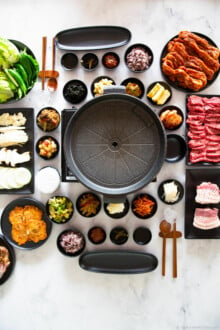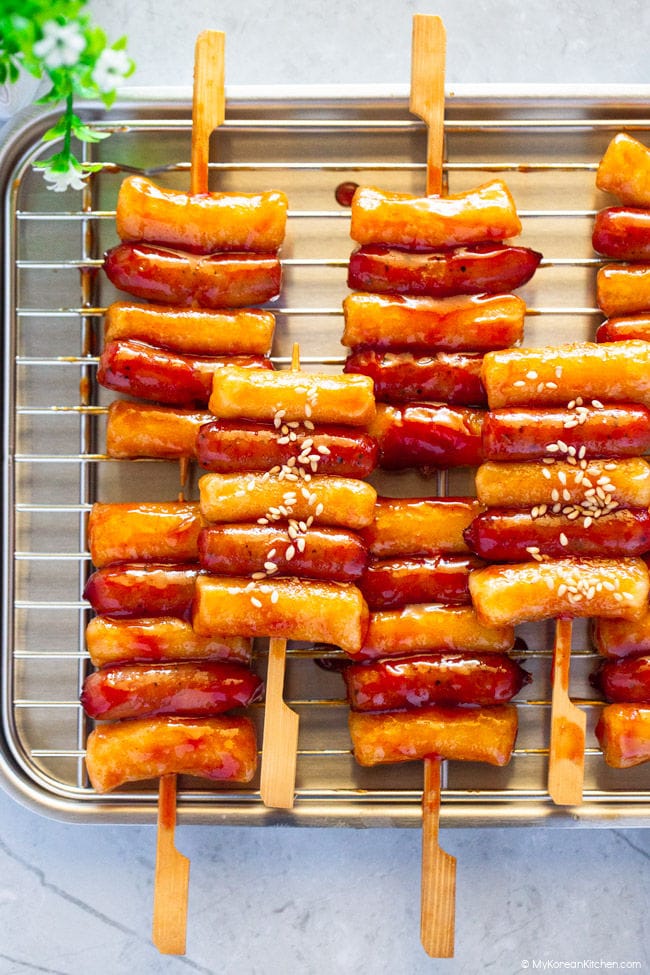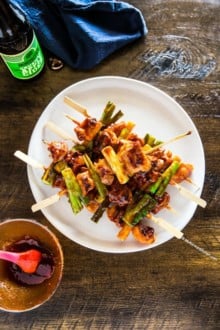Sanjeok is a popular Korean dish that is often served during celebratory occasions. This is a fun dish to make with your friends or family, and it is delicious, too! Learn more here.
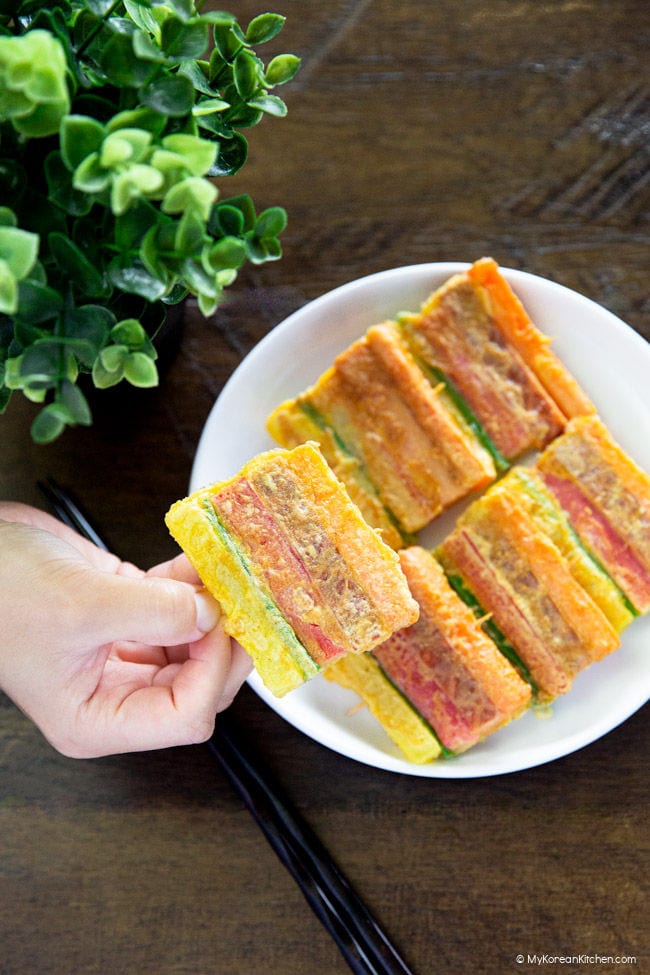
What is Sanjeok
Sanjeok (산적) is a traditional Korean holiday food often served on Korean Thanksgiving Day (Chuseok) and Korean New Year’s Day (Seollal).
It is a popular Korean dish because it’s colorful and has a good combination of tastes. You can customize it to your liking by adding or skipping certain ingredients.
Sanjeok is usually made with thinly sliced meat and vegetables that are skewered on a small wooden stick (e.g. toothpick) and lightly covered with flour and dipped in an egg wash before being cooked on a frying pan.
Normally, for the meat, a high-quality cut of beef is used and the strips of beef are marinated with a soy sauce-based marinade. If you’re feeling lazy, you can even use a store-bought bulgogi marinade bottle for the sauce.
For vegetables, some people might use carrots and green onions. There are also king oyster mushrooms for vegetarians instead of the meat.
Many families also use imitation crab meat and Korean ham instead of using the meat. To give more flavor and texture, some people also use yellow pickled radish.
Making sanjeok and other Korean traditional dishes with the family is a tradition many Koreans hold dear. You get to spend time with your loved ones and share in the workload.
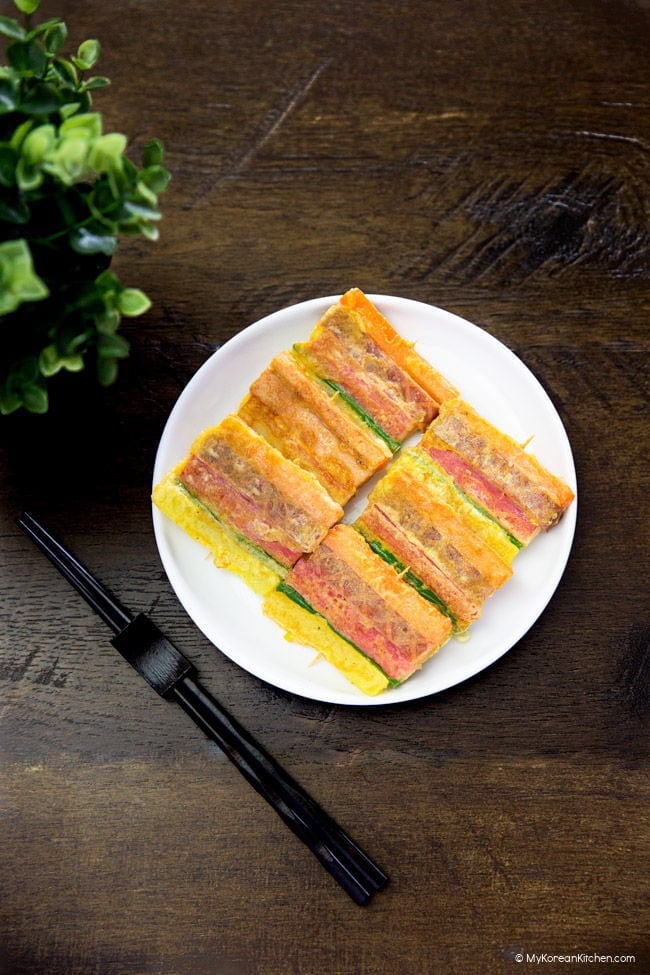
My Best Cooking Tips
- Some people use strips of quality beef instead of ham, which is a more traditional way. (Though, using ham is more budget-friendly and that’s how it’s been done in my family.) If you opt for the meat variation, you’ll want to season it with soy sauce, garlic, and black peppers etc. As I mentioned earlier, you can even use a store-bought bulgogi sauce for a quick fix.
- Toothpicks are perfect for threading ingredients together. Make sure you thread through the centre of the food items.
- To make it easier to thread the food onto the toothpick without breaking it, lightly cook the carrots and ham on a skillet beforehand. Cooking beforehand will also save time as you won’t have to worry about cooking hard vegetables that take a long time to cook.
- A flour mixture is used to help the egg wash stick well, but too much flour should be brushed off, as it can cause the pancakes to under-cook and be visually unappealing – a powdery residue could show. The texture of the dish can also be affected.
- Use a non-stick frying pan or well seasoned cast iron skillet. Wipe the frying pan with kitchen paper between cooking so that other food items don’t stick to sanjeok.
How To Store
Sanjeok is a dish that reheats well. Any leftovers can be refrigerated in an airtight container for three days. You can even freeze it for up to three months, depending on the ingredients used. Defrost it overnight in the fridge.
It can be reheated on the stove or in the microwave.
Other Korean Side Dishes You Might Like
If you like fritter-style dishes, you might also like these Korean dishes. I hope you give them a try soon!
- Hobak Jeon (Korean Zucchini Pancake)
- Pajeon (Korean Green Onion Pancake)
- Enoki Mushroom Pancakes
- Tuna Pancakes
Ingredients for Sanjeok
Main
- 5 strips (about 100g / 3.5 ounces) yellow pickled radish (danmuji), cut into long, thin strips if you didn’t buy the pre-cut version (available at a Korean / Japanese grocery store)
- 5 strips BBQ kimbap ham (about 200g / 7 ounces), cut into long, thin strips if you didn’t buy the pre-cut version (available at a Korean grocery store)
- 8 imitation crab sticks (225g / 7.9 oz)
- 220g / 7.8 oz carrots
- 15g / 0.5 oz green onion, green part only (Use medium thickness green onions)
Batter
- 1/2 cup plain flour
- 1 tsp fine salt
- 1 tsp garlic powder
- 1 tsp onion powder
- 3 eggs, beaten
Substitution Ideas
- You can use high-quality cuts of beef (e.g. rib eye steak) or king oyster mushrooms instead of using Korean BBQ ham. You can also use capsicum (bell peppers) instead of using other colorful vegetables.
- If you’re using beef instead of Korean ham, be sure to cut the meat into pieces that match the size of the other sanjeok ingredients. Then, marinate the meat for at least 30 minutes prior to cooking. You can use a bottle of Korean BBQ marinade, which is available from a Korean grocer. Or, you can make the marinade at home using the below ingredients. The below marinade is based on 170g to 225g (6 to 8 ounces) of beef.
- 1.5 Tbsp soy sauce, regular (I use Kikkoman brand)
- 1/2 Tbsp brown sugar, heaped
- 1/2 Tbsp rice wine (mirin)
- 2 Tbsp apple juice (from a bottle)
- 1 tsp minced garlic
- 1 tsp minced ginger
- 1/8 tsp ground black peppers
How to Make Sanjeok
1. Cut the yellow radish pickle, ham, crab sticks, carrots, and green onion into 2.8 inch (7cm) pieces in length (about the length of your index finger) and about 0.4 inch (1cm) in width. Even out the size of these ingredients before cooking them, both in length and thickness. This will make them look better when served and cook more evenly.
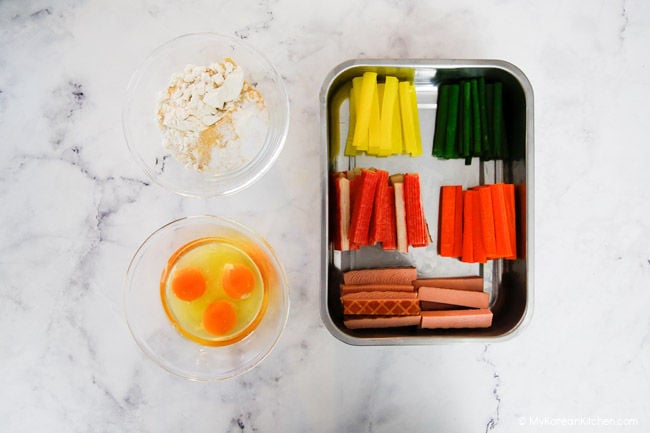
2. Preheat the frying pan on medium-high until the bottom of the pan is well heated. Add cooking oil and lightly cook the carrot sticks over medium-low heat for 2 to 3 minutes. Set aside.
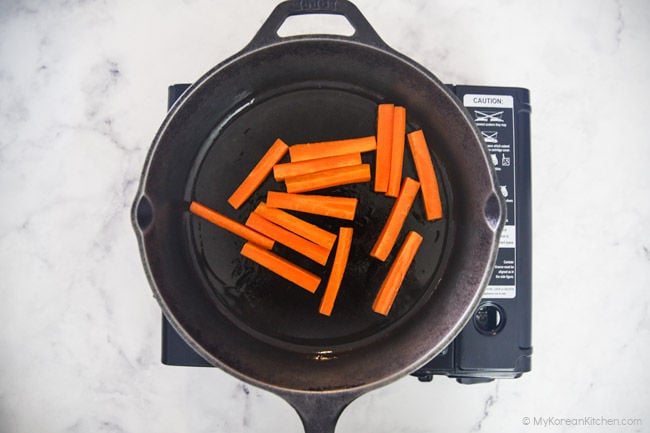
3. In a heated pan, cook the ham over medium-low heat for 2 to 3 minutes. Set aside.
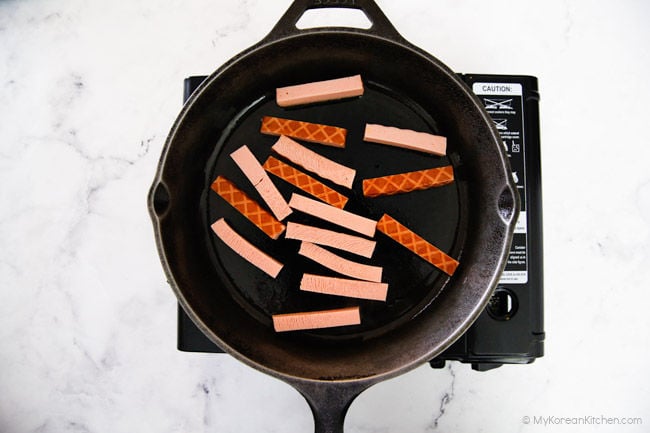
4. Thread the prepared ingredients onto a toothpick, one by one. Be sure to use firmer ingredients on the outside and softer ingredients inside to hold the shape better. (Here’s an example of an order – yellow radish pickle, green onion, crab meat, ham, and carrot.)
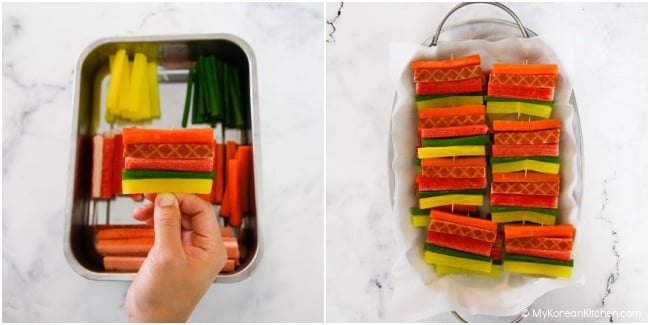
5. Mix the flour, fine salt, garlic powder, and onion powder in a small bowl and transfer the mixture to a small baking tray.
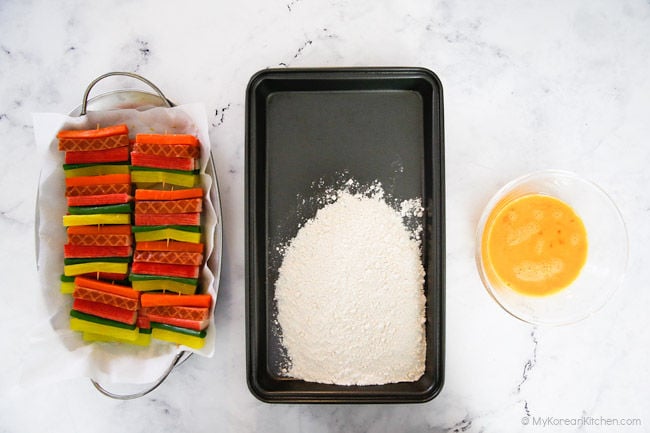
6. Batter the sanjeok skewers with the flour mixture and brush off excess flour. Set the skewer aside while repeating with the remaining ingredients. Once all skewers are coated with flour, soak them in the beaten egg bowl one by one and grill in a pan over medium-low heat (about 1-2 minutes each side). Do not crowd the pan when cooking. Serve warm with other Korean side dishes.
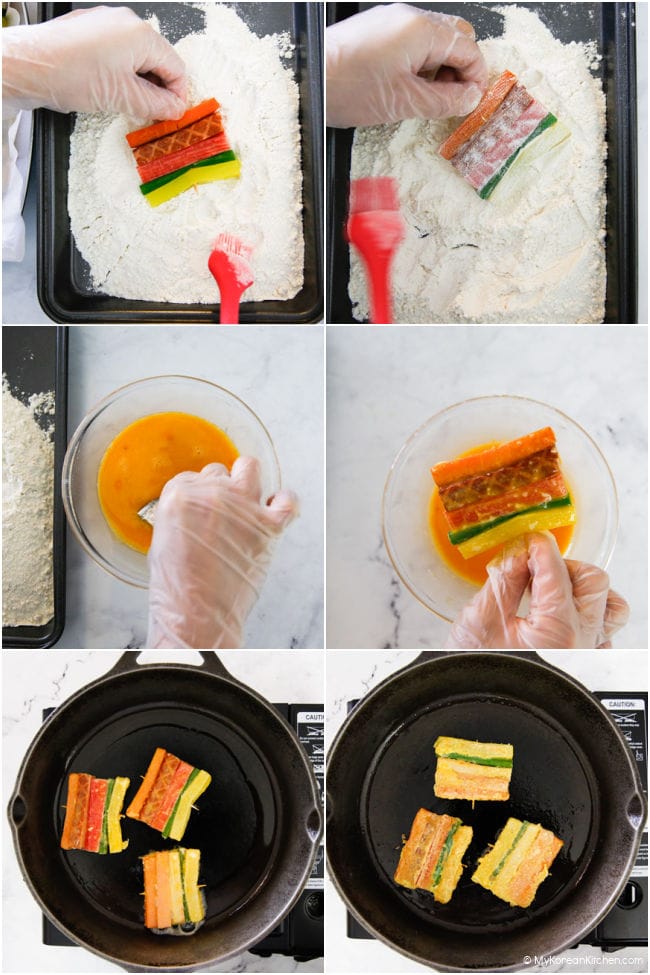
Love Korean food? Browse lots more Korean recipes from my easy Korean recipe collections. And subscribe to my newsletter for all of the latest updates including new recipes, what MKK communities are cooking and K-Dramas!

Sanjeok (Meat and Vegetable Skewers)
Ingredients
MAIN
- 5 strips yellow pickled radish (danmuji), (about 100g / 3.5 ounces) ,cut into long, thin strips if you didn’t buy the pre-cut version (available at a Korean / Japanese grocery store)
- 5 strips BBQ kimbap ham (about 200g / 7 ounces), cut into long, thin strips if you didn’t buy the pre-cut version (available at a Korean grocery store)
- 8 sticks imitation crab (225g / 7.9 oz)
- 220 g carrots (7.8 oz)
- 15 g green onion , green part only (Use medium thickness green onions)
BATTER
- 1/2 cup plain flour
- 1 tsp fine salt
- 1 tsp garlic powder
- 1 tsp onion powder
- 3 eggs , beaten
Instructions
- Cut the yellow radish pickle, ham, crab sticks, carrots, and green onion into 2.8 inch (7cm) pieces in length (about the length of your index finger) and about 0.4 inch (1cm) in width. Even out the size of these ingredients before cooking them, both in length and thickness. This will make them look better when served and cook more evenly.
- Preheat the frying pan on medium-high until the bottom of the pan is well heated. Add cooking oil and lightly cook the carrot sticks over medium-low heat for 2 to 3 minutes. Set aside.
- In a heated pan, cook the ham over medium-low heat for 2 to 3 minutes. Set aside.
- Thread the prepared ingredients onto a toothpick, one by one. Be sure to use firmer ingredients on the outside and softer ingredients inside to hold the shape better. (Here’s an example of an order – yellow radish pickle, green onion, crab meat, ham, and carrot.)
- Mix the flour, fine salt, garlic powder, and onion powder in a small bowl and transfer the mixture to a small baking tray.
- Batter the sanjeok skewers with the flour mixture and brush off excess flour. Set the skewer aside while repeating with the remaining ingredients. Once all skewers are coated with flour, soak them in the beaten egg bowl one by one and grill in a pan over medium-low heat (about 1-2 minutes each side). Do not crowd the pan when cooking. Serve warm with other Korean side dishes.
Notes
- You can use high-quality cuts of beef (e.g. rib eye steak) or king oyster mushrooms instead of using Korean BBQ ham. You can also use capsicum (bell peppers) instead of using other colorful vegetables.
- If you're using beef instead of Korean ham, be sure to cut the meat into pieces that match the size of the other sanjeok ingredients. Then, marinate the meat for at least 30 minutes prior to cooking. You can use a bottle of Korean BBQ marinade, which is available from a Korean grocer. Or, you can make the marinade at home using the below ingredients. The below marinade is based on 170g to 225g (6 to 8 ounces) of beef.
- 1.5 Tbsp soy sauce, regular (I use Kikkoman brand)
- 1/2 Tbsp brown sugar, heaped
- 1/2 Tbsp rice wine (mirin)
- 2 Tbsp apple juice (from a bottle)
- 1 tsp minced garlic
- 1 tsp minced ginger
- 1/8 tsp ground black peppers
Nutrition Info (per serving)
The nutrition information shown is an estimate provided by an online nutrition calculator. It should not be considered a substitute for a professional nutritionist’s advice.

